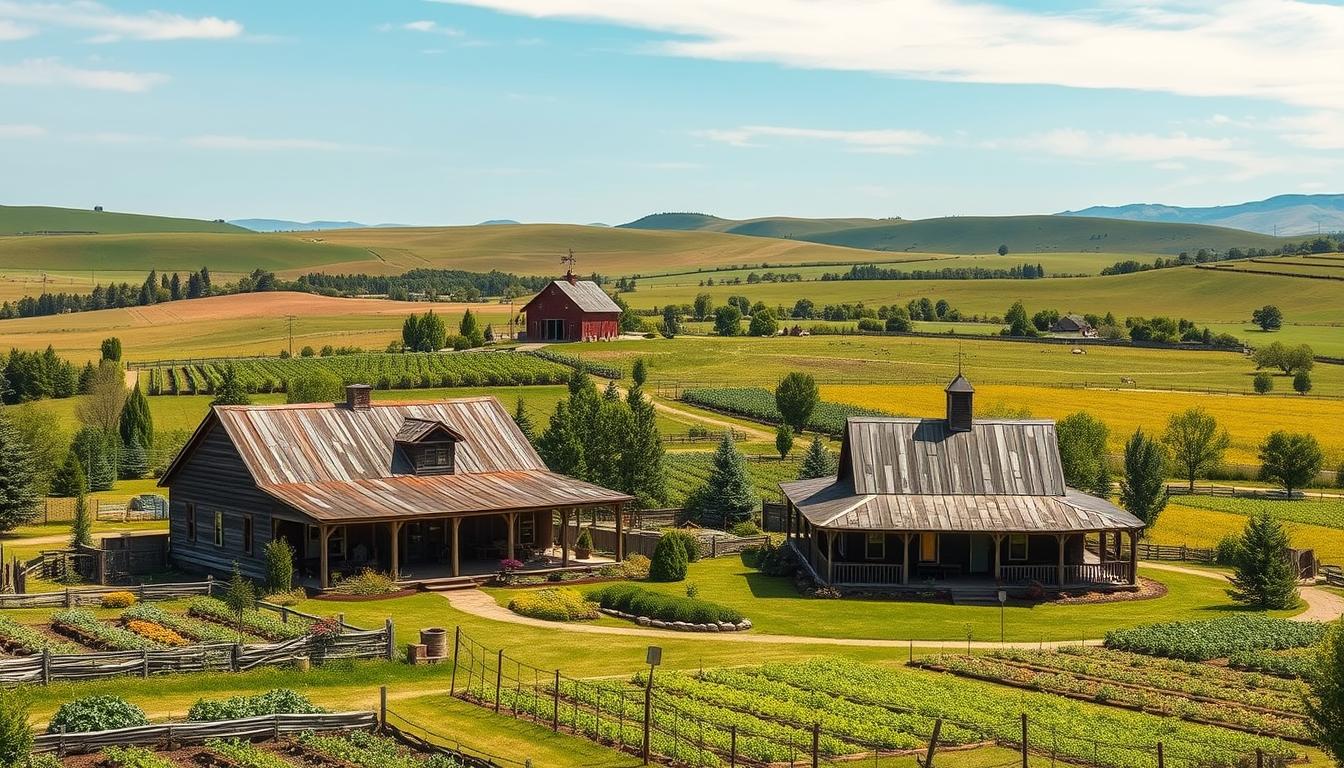Homesteading is more than a lifestyle; it’s a journey toward self-sufficiency. Whether you live in an apartment, a suburban neighborhood, or a rural area, homesteading can be tailored to fit your home and life. Over the past two years, this practice has surged in popularity as people seek food security and a closer connection to nature.
Starting a homestead doesn’t require perfection. It’s about building skills step by step. You might begin with a small garden or try baking your own bread. Over time, these small steps grow into a fulfilling way of living. From my 15+ years of experience, I’ve learned that challenges, like managing chicken health, are part of the process.
Don’t wait for the perfect property or moment. Start your homesteading journey today, no matter where you are. Every small effort brings you closer to a more sustainable and rewarding life.
Key Takeaways
- Homesteading is adaptable to any living situation.
- It’s about gradual skill-building, not perfection.
- Food security and natural living drive its popularity.
- Challenges are part of the journey.
- Start now—don’t wait for the perfect moment.
What Is Homesteading and Why Should You Start?
From urban balconies to rural acres, homesteading adapts to your space and lifestyle. It’s a spectrum of practices, ranging from backyard gardening to full off-grid living. Whether you’re growing herbs on a windowsill or raising chickens in your yard, homesteading is about taking control of your food and resources.
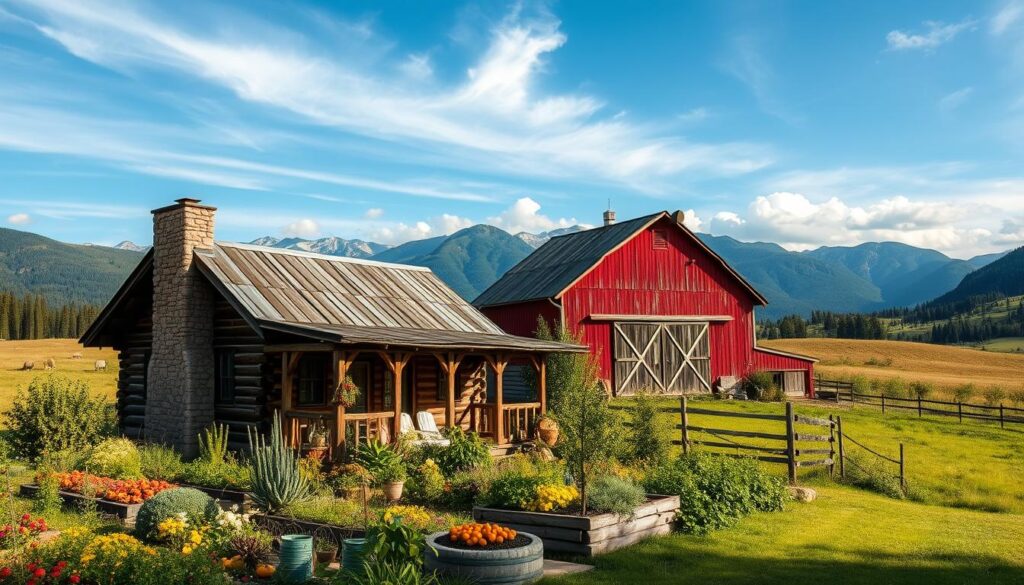
One of the biggest benefits is reducing reliance on grocery stores. Imagine preserving over 300 pounds of homegrown tomatoes annually. This not only saves money but also ensures you have fresh, healthy food year-round. Homesteading empowers you to take charge of your home and life.
Understanding the Homesteading Lifestyle
Homesteading is more than just growing your own produce. It’s about embracing a simpler, more sustainable way of living. Urban dwellers can start small with container gardens, herbs, or even vermicomposting. These practices show that you don’t need acres of land to begin your journey.
For those with more space, homesteading can include raising animals, harvesting rainwater, and composting. These activities not only reduce your environmental footprint but also bring you closer to nature. It’s a lifestyle that fosters independence and resilience.
Benefits of Self-Sufficiency
Homesteading offers numerous advantages, both practical and emotional. Here are some key benefits:
- Mental Health: Hands-on work like gardening reduces stress and improves well-being.
- Environmental Impact: Practices like composting and rainwater harvesting lower your carbon footprint.
- Community Connection: Sharing produce or tips with neighbors builds stronger relationships.
For many people, homesteading is a way to reconnect with nature and live more intentionally. It’s a rewarding journey that transforms not just your home, but your entire life.
How to Homestead: Setting Your Vision and Goals
Setting clear goals is the foundation of a successful homesteading journey. Whether you’re dreaming of a small garden or a full-scale property, defining your priorities ensures you stay focused and motivated. Start by asking yourself key questions: What do you want to achieve? Are you aiming for off-grid energy, or do you want to sell products from your homestead?
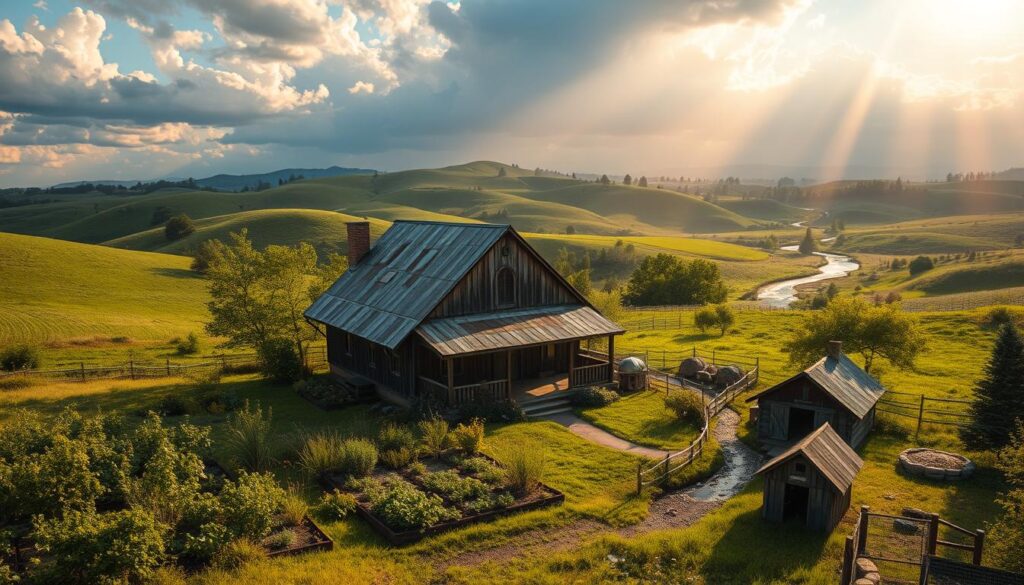
Defining Your Homesteading Priorities
Begin by identifying what matters most to you. Is it food security, sustainability, or financial independence? Prioritize activities like debt repayment and skill-building to set a strong foundation. For example, mastering bread-making before growing wheat can make the process smoother.
Visual tools like vision boards or Pinterest can help you plan future livestock breeds or orchard layouts. These tools keep your goals tangible and inspire you to take action. Remember, your priorities may evolve over time, so stay flexible.
Creating a Long-Term Plan
A long-term plan breaks your vision into manageable steps. Start with a 5-year plan, setting annual milestones. For instance, Year 1 could focus on composting, while Year 3 might include adding chickens. This approach ensures steady progress without overwhelm.
Align your goals with family or partner commitments to avoid burnout. One couple successfully transitioned to homesteading after two years of weekend efforts while working full-time. Their story shows that with patience and planning, anyone can achieve their homesteading dreams.
- Break large goals into phases.
- Set realistic timelines for each milestone.
- Regularly review and adjust your plan as needed.
By taking the time to research and plan, you’ll create a roadmap that turns your homesteading vision into reality. Start small, stay consistent, and enjoy the journey.
Budgeting for Your Homesteading Journey
Financial planning is a cornerstone of any successful homesteading journey. Whether you’re starting small or dreaming big, managing your money wisely ensures sustainability and growth. From paying off debt to finding creative ways to cut costs, every step brings you closer to your goals.
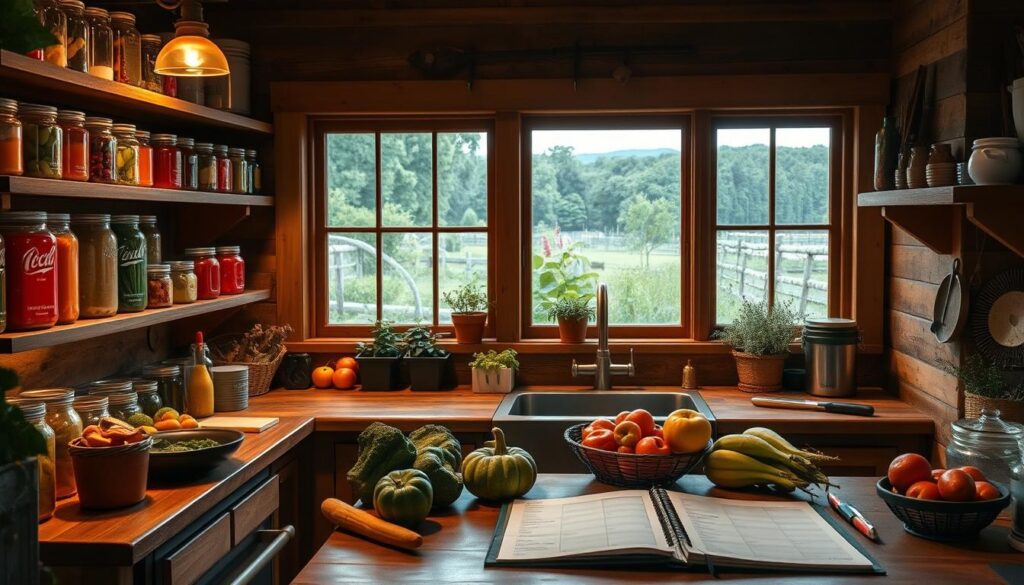
Paying Off Debt and Managing Finances
Before diving into homesteading projects, it’s essential to address any existing debt. The Dave Ramsey debt snowball method is a proven strategy. Focus on paying off smaller debts first, then gradually tackle larger ones. This approach builds momentum and frees up money for future investments.
One family paid off $30,000 in debt within 18 months by cutting their budget by 10%. This allowed them to allocate more resources to their homestead. Taking the time to manage finances upfront ensures a smoother journey ahead.
Cutting Costs and Making Homesteading Affordable
Homesteading doesn’t have to be expensive. Start with low-cost projects like seed swapping or repurposing pallets for raised beds. These small steps can yield significant results without straining your budget.
Offset costs by selling surplus produce or chicks at the local market. For example, selling 50 extra tomato plants can fund chicken feed for a year. This “homestead ROI” makes your efforts self-sustaining.
Avoid impulse buys. A $200 grain mill might seem like a great idea, but if it sits unused, it’s a waste of resources. Focus on tools and supplies that align with your immediate needs.
Take advantage of free resources like library books, YouTube tutorials, and bartering with neighbors. These options reduce expenses while expanding your knowledge and skills.
- Start small with affordable projects like seed swapping.
- Sell surplus produce to fund ongoing expenses.
- Avoid unnecessary purchases that don’t align with your goals.
- Leverage free resources to save money and learn new skills.
By managing your finances wisely, you can create a thriving homestead without breaking the bank. Every dollar saved and every skill learned brings you closer to a self-sufficient life.
Assessing Your Property for Homesteading
Assessing your land is the first step toward a thriving homestead. Understanding your property’s strengths and limitations ensures you make the most of its resources. From sunlight patterns to water flow, every detail matters when planning your self-sufficient lifestyle.
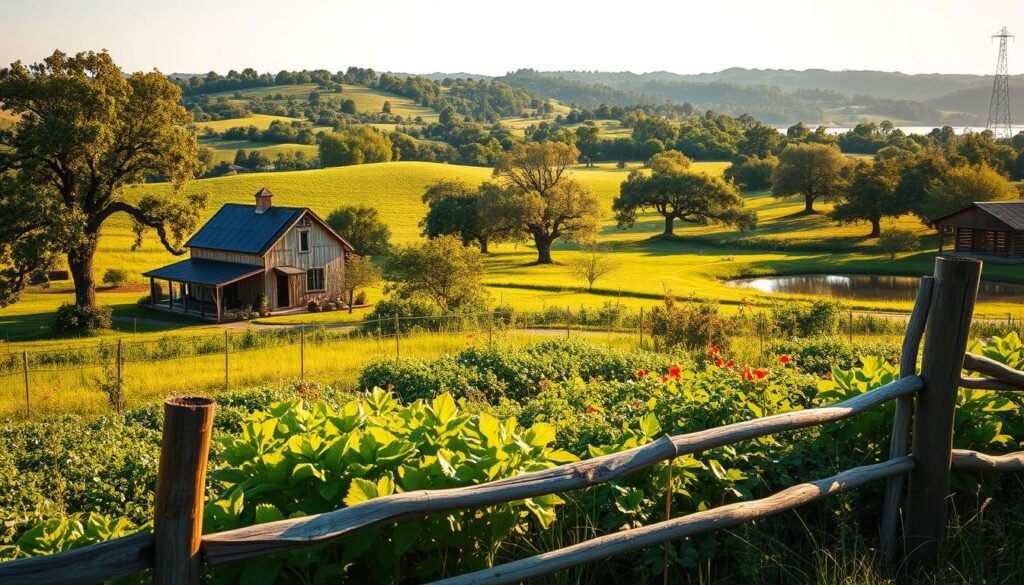
Evaluating Land and Resources
Start by mapping sun exposure across your site. Track shaded versus full-sun zones to determine the best spots for your garden. For example, a family in Texas transformed clay soil into fertile ground in just six months by adding compost and organic matter.
Observe natural water flow to identify areas prone to flooding or drought. Use animals like goats to clear brush or pigs to till forest edges. These methods not only save time but also enhance your property’s productivity.
Understanding Zoning Laws and Restrictions
Research local regulations before starting any projects. Some areas limit the number of chickens you can raise or restrict rainwater collection. One neighbor faced fines for building an unpermitted duck coop, highlighting the importance of compliance.
Consider temporary structures like mobile chicken tractors for flexibility. These allow you to adapt to zoning changes without major investments. Always check for farmstand permits or other requirements to avoid legal issues.
- Map sun exposure for optimal garden placement.
- Test soil pH and amend with compost for better yields.
- Research local laws on animals, water collection, and structures.
- Use temporary solutions like mobile chicken tractors.
By thoroughly assessing your property and understanding local laws, you’ll set a solid foundation for your homesteading journey. Every step brings you closer to a self-sufficient and fulfilling lifestyle.
Starting Small: Homesteading in Limited Spaces
Limited space doesn’t mean limited possibilities for homesteading. Whether you have a tiny balcony or a small backyard, you can create a thriving garden and even raise chickens. With a little creativity, you can turn any area into a productive homestead.
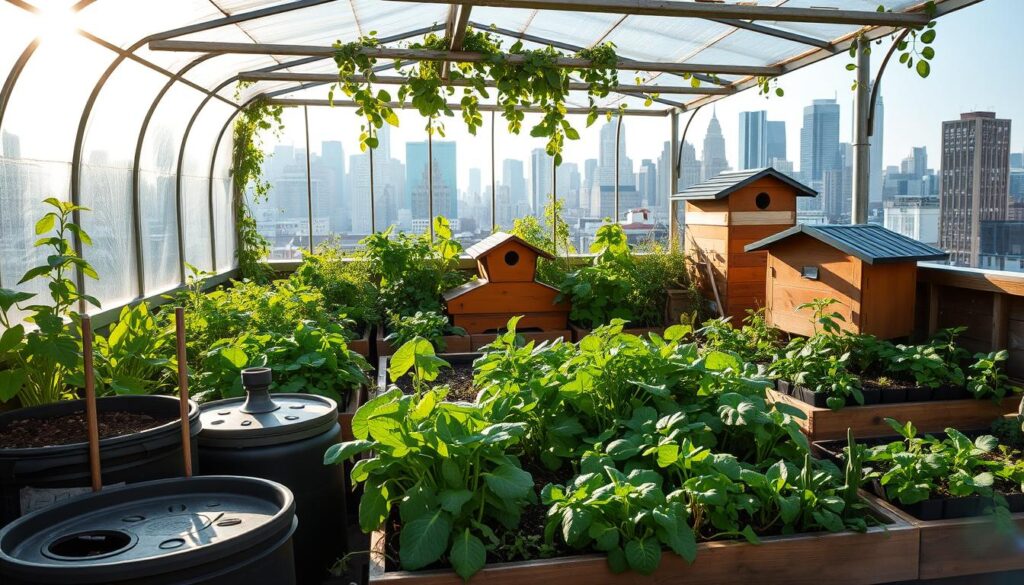
Gardening in Small Areas
Vertical gardening is a game-changer for small spaces. Use trellises for beans or hanging planters for strawberries. Herbs and lettuce thrive in compact setups, making them perfect for urban gardens.
For tomatoes, try determinate varieties in 15-gallon bags. These plants grow well in confined areas and produce a bountiful harvest. Micro-preservation techniques, like freeze-drying herbs, let you enjoy your produce year-round.
Raising Chickens in Urban Settings
Urban chicken keeping is easier than you think. Choose quiet breeds like Silkies to minimize noise. Use odor-reducing coop bedding to keep your neighbors happy.
A Brooklyn family produces 30 eggs weekly from just four hens. Avoid overcrowding, as stress can reduce egg production. With the right tips, even city dwellers can enjoy fresh eggs daily.
Start small, stay consistent, and watch your homestead grow. Every effort brings you closer to a self-sufficient lifestyle, no matter the size of your space.
Building Essential Homesteading Skills
Developing essential skills is the backbone of a successful homesteading journey. Whether you’re growing plants or raising animals, mastering these abilities ensures your efforts yield lasting results. Start with the basics and gradually expand your expertise to create a thriving, self-sufficient lifestyle.
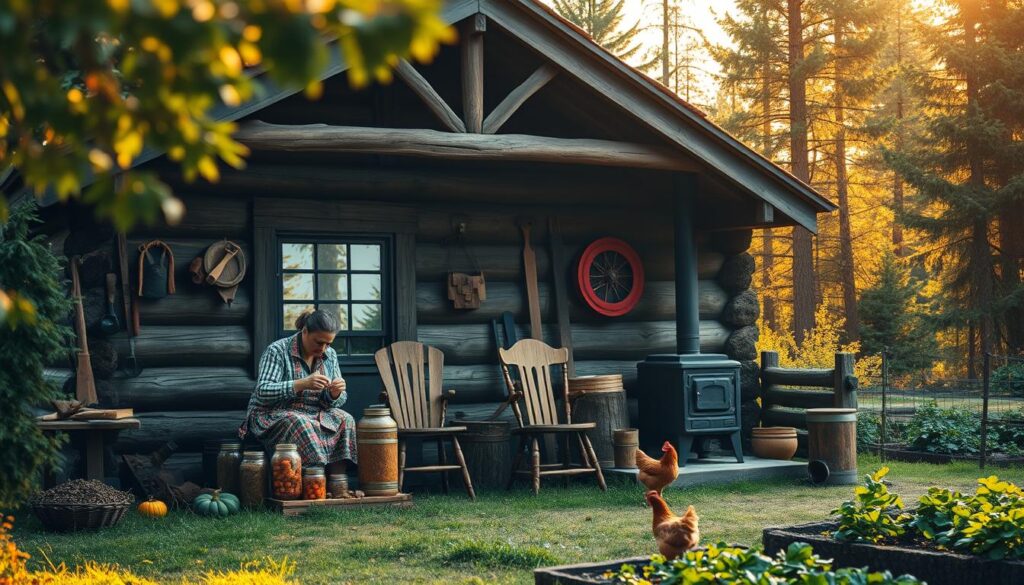
Learning Gardening and Food Preservation
Gardening is a cornerstone of homesteading. Start with easy-to-grow crops like tomatoes and herbs. Experiment with preservation methods like canning or fermenting to extend the shelf life of your harvest. For example, canned tomatoes retain their flavor, while fermented ones offer a tangy twist.
Take classes in cheesemaking or beekeeping to diversify your food production. These skills not only enhance your self-sufficiency but also open doors to new culinary adventures. A well-preserved pantry ensures you enjoy fresh, homegrown food year-round.
Mastering Animal Care and Butchering
Raising animals requires dedication and knowledge. Begin with smaller livestock like chickens or rabbits. Practice butchering techniques using store-bought organs to build confidence before handling live animals. This process ensures ethical and efficient meat production.
Sharpening knives and learning safe carcass handling are critical. These care practices not only improve efficiency but also respect the animals’ lives. Over time, you’ll develop the expertise needed to manage larger livestock like goats or pigs.
- Preserve tomatoes via canning vs. fermenting: Taste-test results.
- Butchering 101: Ethical practices, sharpening knives, safe carcass handling.
- Skill-building timeline: “Month 1: Composting; Month 6: Basic carpentry.”
- Recommend essential tools: Pressure canner, root cellar setup.
- Share a failure-to-success story: First failed sauerkraut vs. award-winning kimchi.
Choosing the Right Animals for Your Homestead
Selecting the right animals is a crucial step in building a successful homestead. Whether you’re raising chickens for eggs or introducing goats for brush clearing, each animal brings unique benefits to your farm. Understanding their needs and contributions ensures a balanced and productive area.
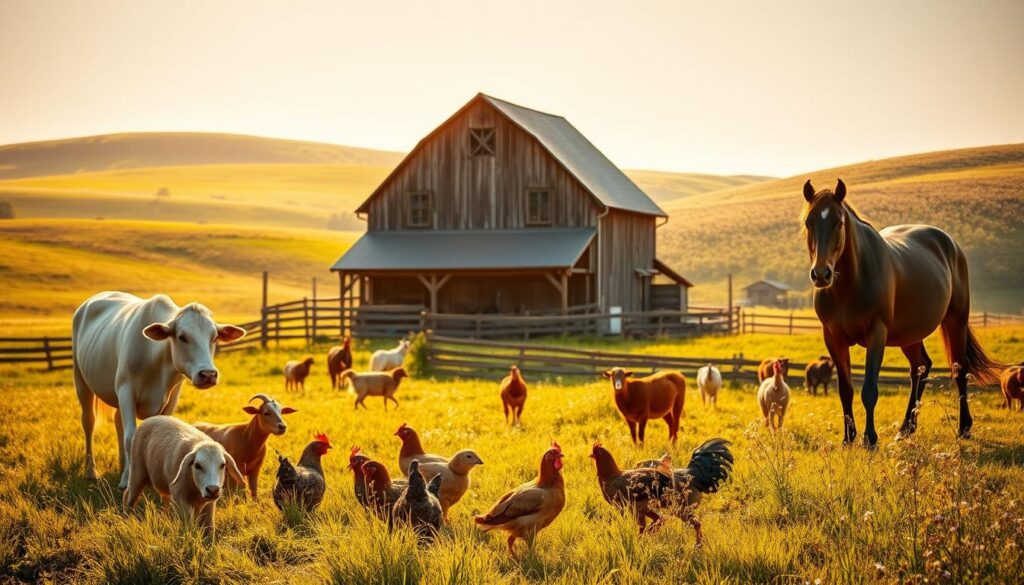
Raising Chickens for Eggs and Meat
Chickens are a popular choice for homesteaders due to their versatility. Meat breeds like Cornish Cross grow quickly, while layers such as Leghorns provide a steady supply of eggs. Dual-purpose breeds like Plymouth Rocks offer both eggs and meat, making them a practical option for small farms.
When choosing breeds, consider their temperament and hardiness. Rhode Island Reds are known for their resilience, while Orpingtons are docile and easy to handle. Proper care, including a balanced diet and clean coop, ensures healthy and productive chickens.
Introducing Goats, Cows, and Pigs
Goats are excellent for clearing brush and maintaining overgrown areas. They’re also a source of milk and meat, adding value to your homestead. Cows, though requiring more space, provide milk in large quantities. A dairy cow can produce 2-3 gallons daily, offsetting feed costs of around $5 per day.
Pigs are natural tillers, making them ideal for preparing soil. Rotational grazing with pigs can clear an acre in just eight weeks. However, avoid impulse buys like ducks, which can be high-maintenance. Focus on animals that align with your homestead’s goals and resources.
- Compare chicken breeds: Rhode Island Reds (hardy) vs. Orpingtons (docile).
- Dairy cow costs: $5/day feed vs. 2-3 gallons milk daily.
- Pig rotational grazing: How 3 pigs cleared 1 acre in 8 weeks.
- Warn against impulse buys: High-maintenance animals like ducks.
- Highlight dual-purpose breeds: Plymouth Rocks for eggs + meat.
By carefully selecting animals that fit your homestead’s needs, you’ll create a sustainable and efficient farm. For more tips on starting your journey, check out this guide on gardening for beginners.
Creating a Sustainable Water and Energy System
Sustainability begins with smart resource management on your homestead. Efficient use of water and energy ensures long-term success. Whether you’re harvesting rainwater or exploring off-grid power, these systems are essential for a self-sufficient lifestyle.
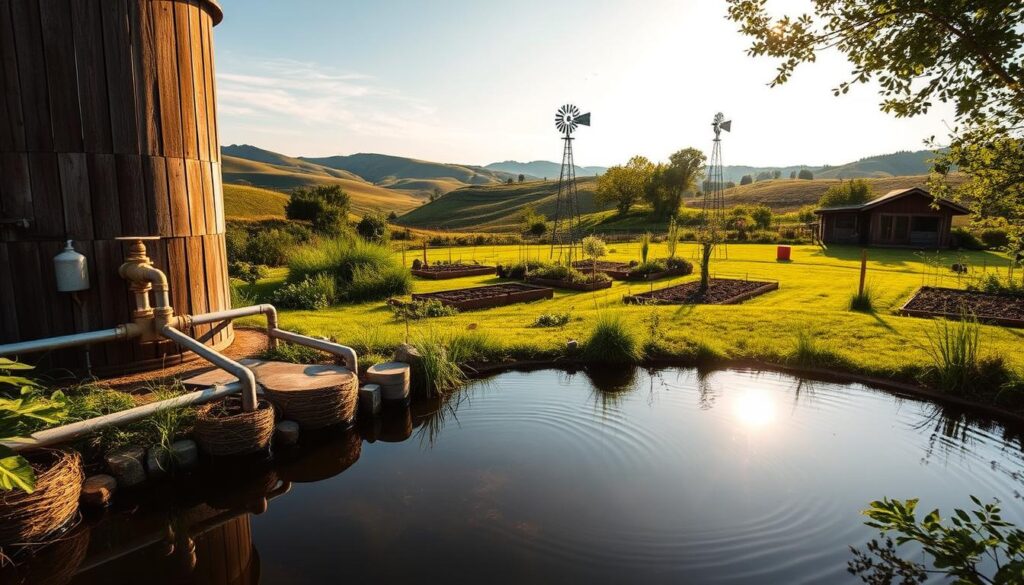
Harvesting Rainwater and Managing Water Resources
Rainwater harvesting is a simple yet effective way to conserve water. A DIY rain barrel setup costs around $50 and can yield up to 1,000 gallons seasonally. Rooftop catchment systems can capture over 300 gallons, making them ideal for irrigation or livestock needs.
For hilly properties, gravity-fed irrigation is a practical solution. Calculate the slope to ensure proper water flow. This method reduces reliance on pumps and saves energy. Always check local regulations to avoid issues with illegal well drilling.
Exploring Off-Grid Energy Options
Off-grid energy systems provide independence from utility companies. Solar panels and wind turbines are popular choices, but each has its pros and cons. Here’s a quick comparison:
| Option | Cost | Efficiency | Maintenance |
|---|---|---|---|
| Solar Panels | $10,000-$20,000 | High in sunny areas | Low |
| Wind Turbines | $15,000-$30,000 | High in windy areas | Moderate |
One family reduced their electric bills by 70% using solar panels combined with a wood stove. However, off-grid systems require backup solutions for cloudy weeks. Battery storage is essential but can be costly.
By carefully planning your water and energy systems, you’ll create a sustainable and efficient homestead. Every step brings you closer to a self-sufficient way of living.
Overcoming Challenges in Homesteading
Every homesteader faces obstacles, but resilience turns setbacks into stepping stones. From predator attacks to equipment breakdowns, challenges are part of the journey. The key is to stay focused and adapt to whatever comes your way.
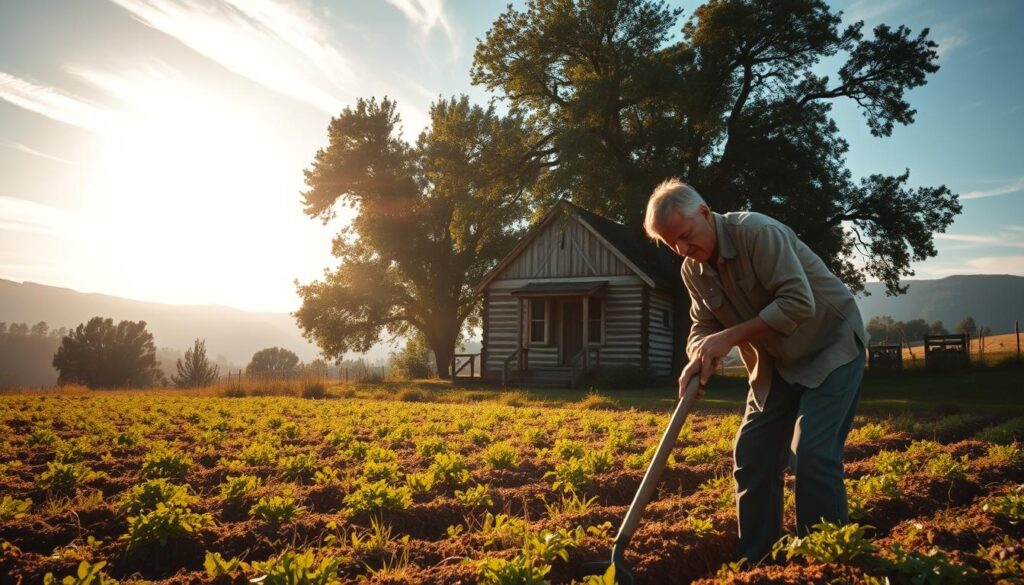
Dealing with Unexpected Setbacks
Unexpected issues can arise at any time. One homesteader shared a story about a chicken prolapse emergency. With quick thinking and guidance from a Facebook group, they saved the hen. This experience highlighted the importance of mentorship and community support.
Common crises include crop failures, predator attacks, and equipment malfunctions. Preparing for these events can make a big difference. For example, winterizing coops and storm-proofing greenhouses can prevent seasonal disasters.
Staying Motivated Through Difficult Times
Staying motivated during tough days is crucial. Journaling progress and celebrating small wins can keep your head in the game. One family rebuilt their barn after a tornado destroyed it in 2020. Their determination turned a devastating event into a story of success.
Community support is another powerful motivator. Bartering vet services for honey or sharing tips with neighbors builds a strong network. This camaraderie makes the work feel less overwhelming.
- Common Crises: Predator attacks, crop failures, equipment breakdowns.
- Mental Resilience: Journal progress, celebrate small wins.
- Community Support: Barter services, share resources.
- Example: Rebuilding after a tornado destroyed a barn in 2020.
- Seasonal Prep: Winterize coops, storm-proof greenhouses.
Conclusion: Embracing the Homesteading Lifestyle
The homesteading lifestyle offers a unique way to connect with nature and resources. Start small, build essential skills, and adapt to your land’s potential. Over time, these efforts lead to a fulfilling and self-sufficient life.
Take inspiration from a family producing 80% of their food on just one acre. Their success shows that homesteading is achievable with dedication and creativity. Remember, your imperfect homestead is better than waiting for perfection.
Join local co-ops or share your first harvest photos online to connect with like-minded individuals. For further guidance, explore recommended books, tools, and courses. Every step you take brings you closer to a sustainable and rewarding living experience.

